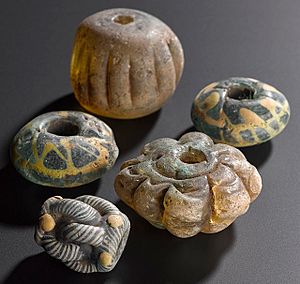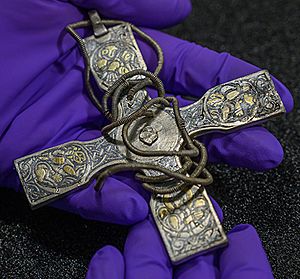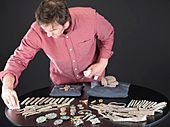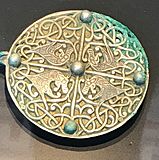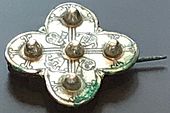Galloway Hoard facts for kids

The Galloway Hoard is an amazing collection of over 100 gold and silver items from the Viking Age. It was found in September 2014 in Dumfries and Galloway, Scotland. Experts say it's "one of the most important Viking hoards ever found in Scotland."
A metal detector enthusiast named Derek McLennan discovered the hoard. He reported his find to the authorities. An archaeologist then carefully dug up the treasure. They found a rich and unusual collection of jewelry and other objects. These items came from the Viking world, Anglo-Saxon England, and other parts of Europe.
The hoard was likely buried sometime between the mid-800s and mid-900s. No one knows exactly why it was buried. Today, the Galloway Hoard is kept at the National Museum of Scotland.
The hoard includes many different gold and silver items. There are armbands, a Christian cross, brooches, and silver bars called ingots. It also has what might be the biggest silver pot ever found from the Carolingian Empire. The items came from places like Ireland, Scandinavia, and central Europe. They were made over a long time, perhaps a couple of centuries.
While other Viking finds exist, the Galloway Hoard is special. It has a unique mix of gold, silver, glass, enamel, and even textiles (cloth). Stuart Campbell from the National Museum of Scotland said, "Nothing like this has been found in Scotland before." He added that it will take time for experts to study everything and understand its full importance.
In December 2018, the museum announced that parts of the hoard would travel to other Scottish museums. After this tour, some pieces will be shown in Edinburgh. A large part of the hoard will also be on long-term display at Kirkcudbright Galleries.
Contents
How the Hoard Was Found
The Galloway Hoard was discovered on land owned by the Church of Scotland. Derek McLennan, a metal detectorist from Ayrshire, found it. He was with two churchmen, Rev Dr. David Bartholomew and Pastor Mike Smith. They all enjoyed using metal detectors.
Derek had been searching this area for over a year. After about an hour of searching, he found a silver object. It turned out to be an arm ring. Derek said, "I thought it was a silver spoon at first." But when he wiped it clean, he saw a special design. He knew right away it was Viking. He ran to Bartholomew, shouting "Viking!"
This wasn't Derek's first big discovery. In 2013, he found Scotland's largest collection of medieval silver coins.
Derek reported the Galloway Hoard to Scotland's Treasure Trove Unit. An archaeologist named Andrew Nicholson then started digging with Derek's help. They found many items about 60 centimeters (2 feet) deep.
After removing the first layer of items, Derek used his metal detector again. He found a second, deeper layer of the hoard! One amazing find was an early Christian silver cross. Bartholomew described it as "a heart-stopping moment." The cross was lying face-down under silver bars and arm-rings. It even had a fine silver chain still attached.
The National Museum of Scotland later acquired the entire hoard. This means it now has a permanent home in Scotland for everyone to see and learn from.
Treasures Inside the Pot
One of the most exciting parts of the hoard was a large silver pot. This pot was one of the oldest items in the collection. It might have been over 100 years old when it was buried. The pot was made of a silver alloy and was found wrapped in cloth. Its lid was still in place.
Experts used X-rays to look inside the pot before opening it. When they finally opened it, they found even more treasures! Inside were:
- Silver brooches from Anglo-Saxon England.
- An Irish silver brooch.
- Silk fabric from the Byzantine Empire, near Constantinople (modern-day Istanbul).
- A gold bar (ingot).
- Gold and crystal objects, also wrapped in cloth.
This pot might have been a special family treasure passed down through generations. The silver cross found nearby might have come from Dublin. It has unique designs on its four arms. Derek McLennan thought these designs might represent the four Gospels.
Messages in Runes
Five of the silver armbands have special carvings called runic inscriptions. Even though this is a Viking hoard, these carvings are in Anglo-Saxon runes. They spell out Anglo-Saxon names.
David Parsons from the University of Wales identified one name as Ecgbeorht. This is "Egbert" in modern English. It was written as EGGBRECT (ᛖᚷᚷᛒᚱᛖᚳᛏ). He thinks each of the five names might belong to someone who owned part of the hoard. These people might have been the ones who buried it.
At that time, Galloway was part of Anglo-Saxon Northumbria. So, the people who buried the hoard could have been Anglo-Saxons living in the area.
Why Was It Buried?
No one knows for sure why the Galloway Hoard was buried. Stuart Campbell suggested it was hidden for safekeeping. He compared it to "a safety deposit box that was never claimed."
The discovery might change how we think about Vikings and Scotland. We often imagine Vikings as raiders from other lands. But this area was a place where Vikings settled, traded, and lived. The people there were culturally and linguistically Norse.
It's also a mystery why the hoard was buried in two separate layers. Maybe it was buried in two different times by the same person. Or, perhaps the person wanted to hide the most valuable items, like the gold and the Carolingian pot, deeper for extra safety.
The items in the two layers are different. The top layer had smaller, less valuable items. These would have been like "loose change" in the Viking economy. The bottom layer held much rarer and more special treasures.
The Hoard's New Home
The Galloway Hoard is now owned by the National Museum of Scotland. In 2017, the hoard's value was set at £1.98 million. The museum worked hard to raise the money to buy it. Thanks to a fundraising campaign, they succeeded.
This means the Galloway Hoard has a permanent home in Scotland. Everyone can visit the museum to see these amazing treasures from the Viking Age.


